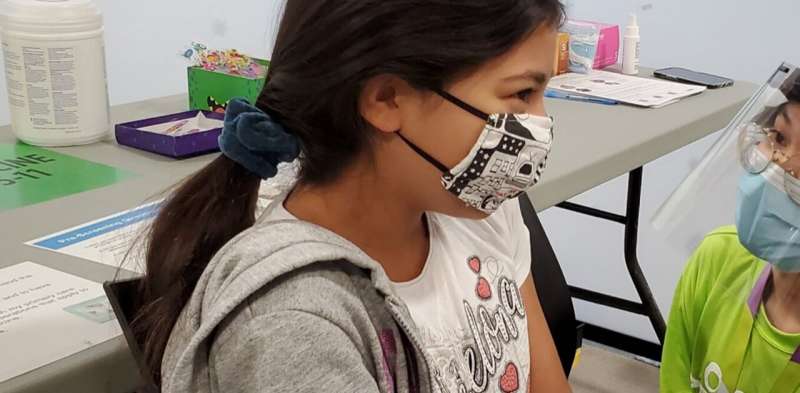Children ages 5 to 11 are getting COVID-19 vaccinations: What this might mean for the holidays and the Omicron variant

Public Health Canada approved the use of Pfizer/BioNTech mRNA vaccine for children ages five to 11 on Nov. 19. The decision was highly anticipated as parents—including one of the authors—have been waiting to protect school-age children in the face of growing SARS-CoV-2 positive cases and spare them from another interruption of the school year. (Children ages five to 11 represent 7.5 percent of all the cases in Canada, with potentially life-threatening consequences.)
As soon as the provincial online booking system became available on Nov. 23, Dasantila booked her daughter for an appointment over the weekend, not wanting her to miss any school days. Then she started planning how to offer comfort on the day of the vaccination: her daughter does not like needles—the sight of a needle on TV or in a magazine or even mentioning one makes her cringe, and she instinctively covers her left arm and says she is in pain.
The following day, however, she came home and asked whether her vaccination had been booked. When gently informed that it would be on the weekend, she inquired why not sooner? Dasantila was shocked that her little one, who usually had to be coaxed with chocolate to get her shots, was not happy that her vaccination was not booked sooner. Hiding her shock, Dasantila asked why she wanted it sooner, and her daughter said everyone in her class was getting it sooner.
It's a reminder that children may be stronger than we imagine them to be, and may exceed our expectations. It's also another reason to thank teachers who have been consistent in their message about the importance of public health measures to protect themselves and others.
What is the vaccination coverage in Canada?
The approval of vaccination for children ages five to 11 years comes at a critical point in the pandemic here in Canada. In Ontario, where we live, cases are slowly creeping up (the positivity rate—the percentage of people tested who get a positive result—is fluctuating around three percent), and outbreaks in the province's elementary schools are at their highest level since the pandemic began.
A slow increase in positive cases was expected as people gather more indoors due to the cold weather, more venues opened to full capacities and travel bans were lifted. But we don't know at what rate this trend will continue, so public health measures and vaccines are the thread we must hold on to.
The participation of five-to-11-year-old children in vaccination programs will make 90 percent of the population eligible to get vaccinated (this age groups accounts for as many as three million children). This level of vaccination can make a substantial difference in "making it or breaking it" for the health-care system in Canada, which has been strained and not at a full capacity when it comes to serving non-COVID-19 patients.
Currently, in Canada, 76 percent of the total population is fully vaccinated (86 percent of people 12 and older). In Ontario, 77 percent of total population is fully vaccinated (87 percent of people 12 and older). Partial vaccination coverage (single dose) among children ages five to 11 is 5.8 percent in Canada and 22 percent in Ontario.
Where we are heading?
A study by the Laboratory for Industrial and Applied Mathematics at York University shows that, with the current Ontario level of full vaccination in the population of 12 and older and in the absence of vaccination for children under 12, the COVID-19 attack ratio (defined as the proportion of infected individuals in the population during an outbreak) among kids under age 12 can reach 18 percent (the study is not yet peer reviewed).
This level of infection in this age group can persist even if the social activity of the populations aged 12 and above remains below 75 percent of the pre-pandemic level. An effective vaccination among kids five to 11 years old, fortunately, can reduce this attack ratio to under 0.2 percent.
A recent report by the same group, published in the PHAC modeling group Weekly Report (October Report) shows that the attack ratio among all kids under 12 can be lowered to below two percent if half of kids in this age group are fully vaccinated, and to 0.17 percent with a 90 percent vaccination rate in this age group. A game changer!
Omicron and the holidays
The emergence of Omicron, a variant that is considered to be more transmissible than Delta, adds more urgency to getting younger ones vaccinated to curb circulation in the community and protect those that remain vulnerable even after being fully vaccinated (including the booster shots). Numerous studies show that vaccines protect against severe cases of COVID-19 disease, and reduce infection and transmission.
So as the holidays approach, encourage and support those who remain on the fence when it comes to the vaccines, and continue to embrace public health measures: face masks, physical distancing, limited gatherings and hand hygiene. The holidays may seem a bit brighter this way!
This article is republished from The Conversation under a Creative Commons license. Read the original article.![]()





















